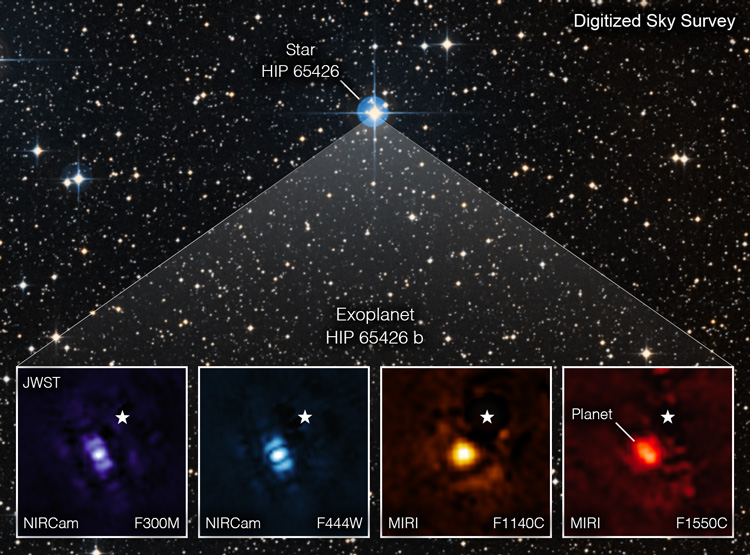Webb Telescope Images Jupiter-Like Planet 350 Light Years Away

Checking off one of its key goals, the James Webb Space Telescope (JWST) imaged its first exoplanet — a young, gas giant planet six to 12 times more massive than Jupiter orbiting a star 350 light years from Earth.
“The JWST cameras were designed to take photos of exoplanetary systems, and we just demonstrated that everything works like a charm,” said astronomer Paul Kalas, an adjunct professor of astronomy at the University of California, Berkeley, and a co-investigator for the telescope’s Early Release Science (ERS) program focused on exoplanets. “The planet was first discovered in 2017 by ground-based observatories, but JWST is able to capture the planet’s warm emission at longer, infrared wavelengths.”
The star, HIP 65426, is very young and hot, having recently completed its planet-forming stage. It lies in the southern constellation Centaurus.
“This planetary system is only 14 million years old, and these new data will advance our knowledge of how planets form and evolve,” Kalas said.
The young planet, which is designated HIP 65426b, is several thousand times fainter than the star, so sophisticated cameras aboard JWST — the Near-Infrared Camera (NIRCam) and Mid-Infrared Instrument (MIRI) — had to artificially eclipse the starlight using coronagraphs in order to capture the images. This is the first image of an exoplanet in mid-infrared wavelengths — that is, wavelengths greater than 5 microns (a millionth of a meter, or a thousandth of a millimeter).
“Obtaining this image felt like digging for space treasure,” said team member Aarynn Carter, a postdoctoral researcher at UC Santa Cruz who led the analysis of the images. “I think what’s most exciting is that we’ve only just begun. There are many more images of exoplanets to come that will shape our overall understanding of their physics, chemistry and formation. We may even discover previously unknown planets, too.”
Carter is first author of a paper describing the results that has been submitted for publication. A non-peer reviewed preprint is available online.
The ERS exoplanet team was tasked with evaluating how well the NIRCam and MIRI work in suppressing starlight, so it pointed JWST toward a known exoplanet. The team’s analysis showed that JWST is so sensitive that it could detect young Saturn-mass planets, a capability unmatched by any other astronomical observatory.
Much of the expertise needed to design these cameras and science programs originated from sophisticated, ground-based efforts, such as with UC’s Lick and Keck observatories, Kalas said. A former UC Berkeley graduate student, Marshall Perrin, worked to commission JWST and trained with Kalas and professor James Graham at both Lick and Keck more than a decade ago. Perrin is also a member of the ERS exoplanet team, as are current Berkeley astronomers Keming Zhang and Marta Bryan.
Webb is an international mission led by NASA in collaboration with its partners, the European Space Agency and Canadian Space Agency.
